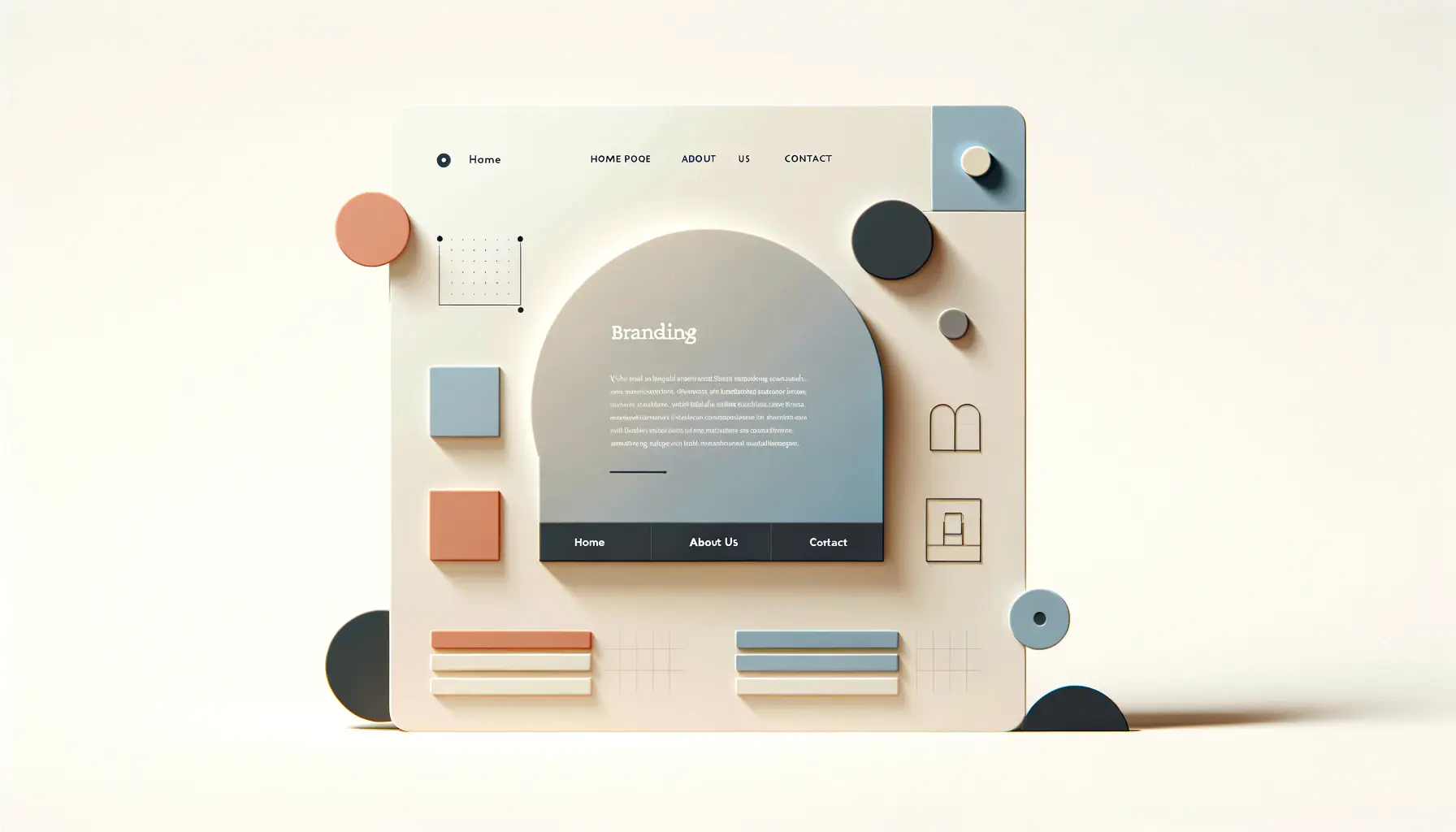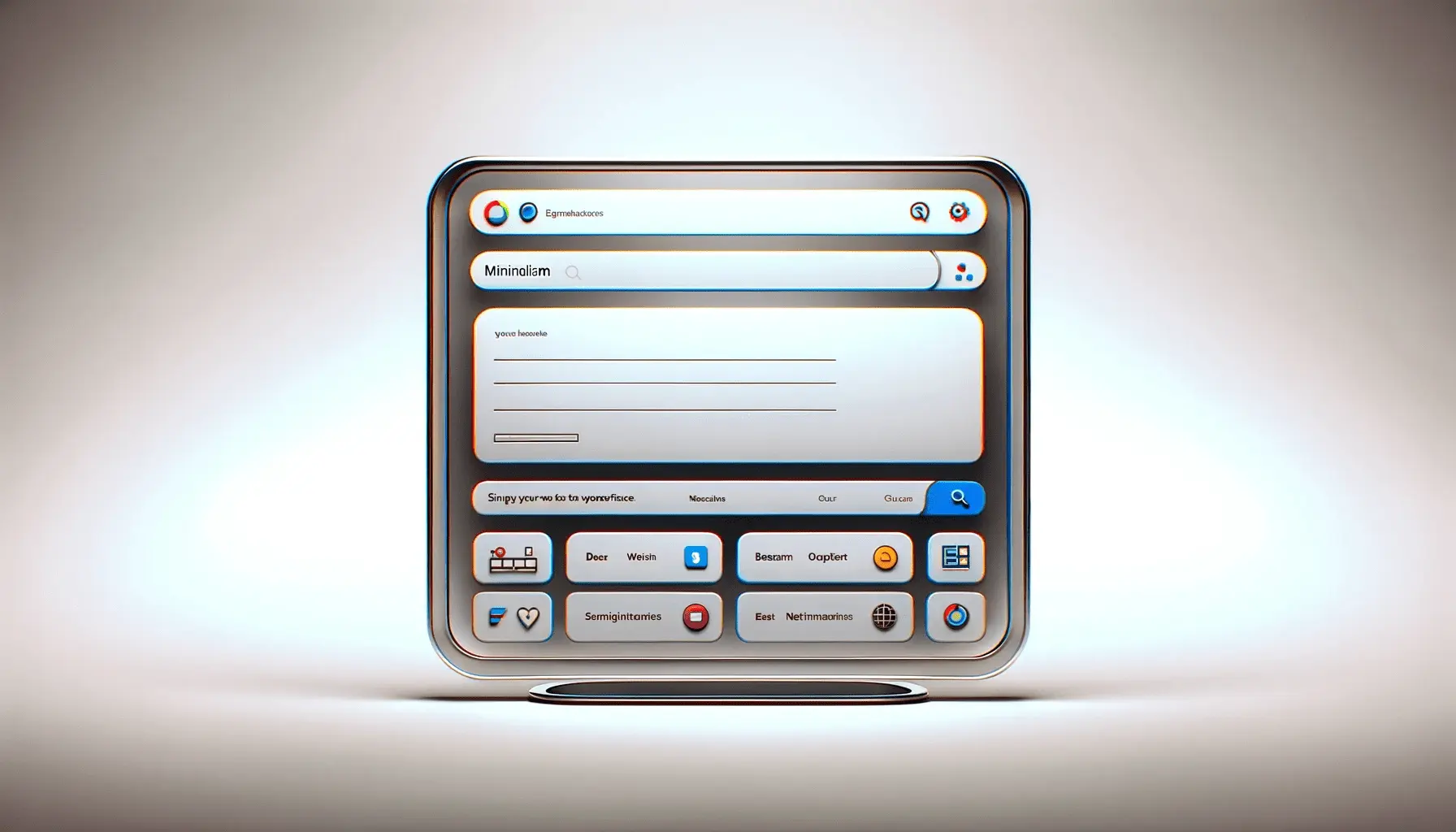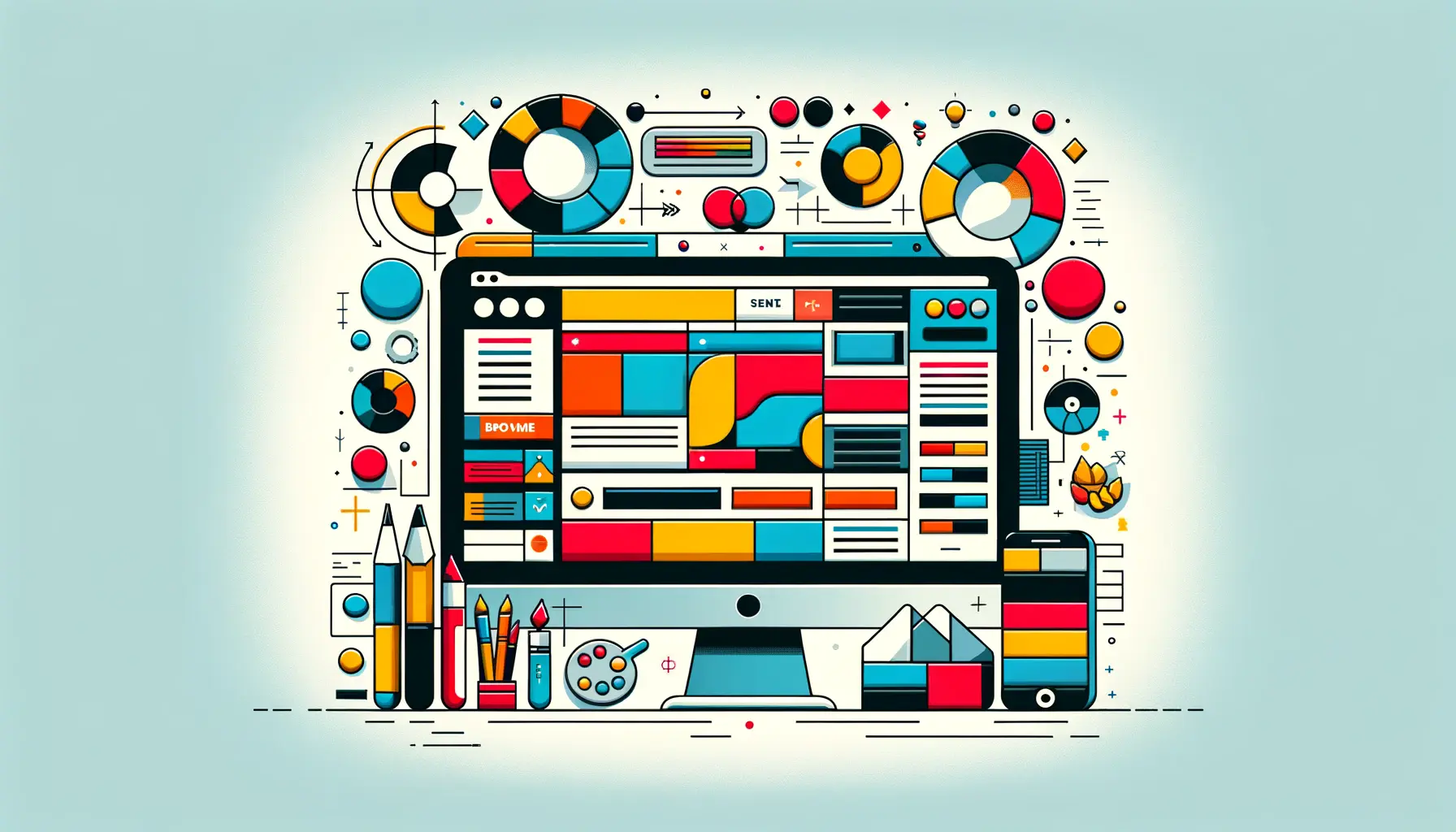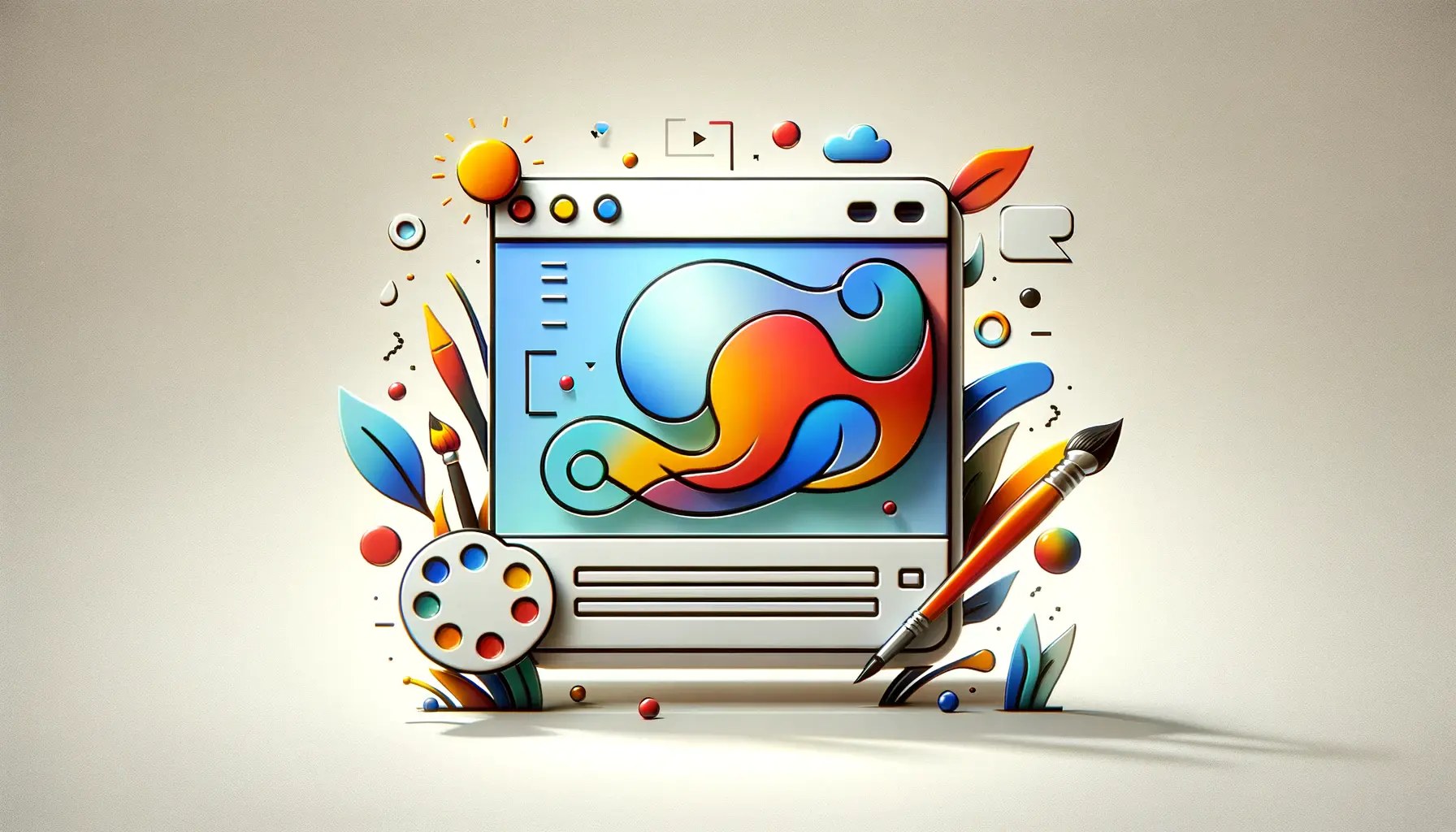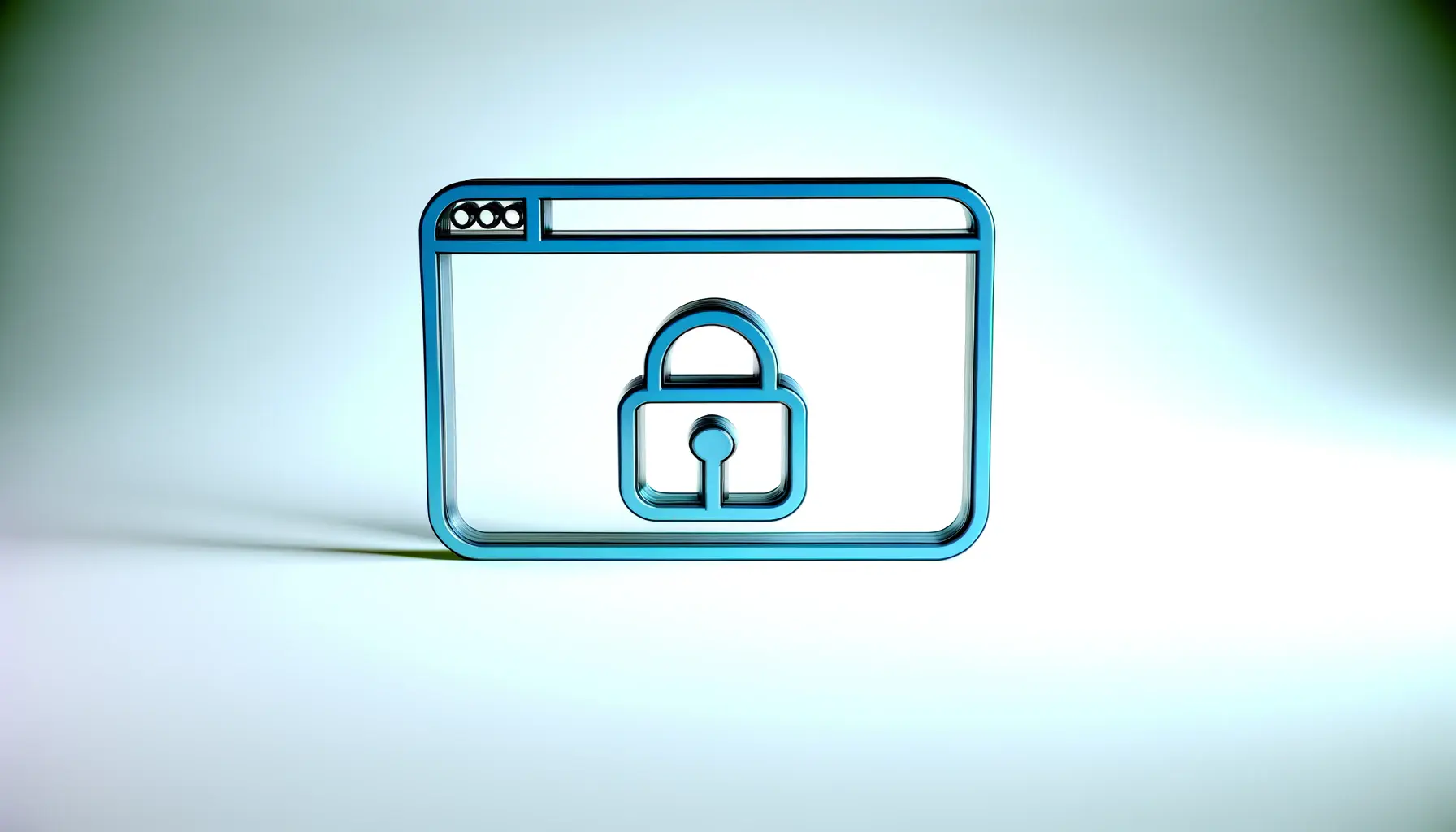In today’s fast-paced digital world, the concept of minimalism has taken center stage in branding and web design.
This design philosophy, rooted in the idea of simplicity and focus, has shown remarkable effectiveness in creating engaging and memorable brand identities.
Minimalism in branding and web design is not just a trend; it’s a strategic approach that can lead to a more profound connection with the target audience.
By stripping away the non-essential elements, designers and brands can highlight what truly matters, ensuring the message is conveyed clearly and directly.
The rise of minimalism in branding and web design reflects a broader cultural shift towards valuing experience over possession, clarity over complexity.
In this context, minimalism becomes more than an aesthetic choice; it’s a statement of values and priorities.
Brands that adopt a minimalist approach are seen as confident and authentic, capable of cutting through the noise to deliver a pure and focused message.
This approach resonates with consumers who are increasingly seeking simplicity and authenticity in a cluttered digital landscape.
- Understanding Minimalism in Design
- Key Elements of Minimalist Design
- The Impact of Minimalism on User Experience
- Minimalism in Brand Identity and Recognition
- Challenges and Considerations in Minimalist Design
- Strategies for Implementing Minimalism Effectively
- Case Studies: Success Stories of Minimalism in Design
- Future Trends in Minimalism for Branding and Web Design
- Embracing Minimalism: A Path to Clarity and Engagement in Branding and Web Design
- Key Takeaways for Brands and Designers
- Forging Ahead with Minimalism
- FAQs on Minimalism in Branding and Web Design
Understanding Minimalism in Design
At its core, minimalism in design focuses on the essentials.
It’s about removing the superfluous elements to emphasize content, functionality, and user experience.
This design philosophy is grounded in the belief that less is more, and that simplicity can lead to a more engaging and effective brand presence.
In branding and web design, minimalism can manifest in various ways, from clean lines and ample white space to a restrained color palette and straightforward typography.
The benefits of adopting a minimalist approach in branding and web design are multifaceted.
It not only enhances the aesthetic appeal of a brand but also improves user experience by making navigation more intuitive.
Furthermore, minimalism can significantly boost a brand’s memorability.
In a world where consumers are bombarded with information, a minimalist brand can stand out by offering a clear and concise message.
This clarity of communication is crucial in building brand recognition and loyalty.
Key Elements of Minimalist Design
Simplicity in Color and Typography
One of the hallmarks of minimalist design is the use of a limited color palette.
By choosing a few select colors, brands can create a strong visual identity that is easy to recognize and remember.
Similarly, simplicity in typography—opting for clean, readable fonts—ensures that the message is accessible to everyone.
These elements work together to create a cohesive and impactful brand image that communicates effectively with the target audience.
Moreover, the strategic use of color and typography in minimalism goes beyond aesthetics; it plays a crucial role in guiding the user’s attention.
By highlighting key information with color contrasts or typographic emphasis, brands can ensure that their most important messages are seen and understood.
This level of focus is invaluable in driving engagement and action from the audience.
Minimalism in branding and web design is not merely an aesthetic choice; it’s a strategic approach that enhances user experience and brand memorability.
Maximizing White Space
White space, or negative space, is another critical element in minimalist design.
Far from being “empty” space, it serves a vital function in creating a layout that breathes.
White space can help to break up content, making it more digestible and easier to navigate.
It also plays a significant role in focusing attention, allowing the most crucial elements of the brand or website to stand out.
Effective use of white space contributes to a clean and uncluttered user interface, which is essential for a positive user experience.
It allows users to navigate a website effortlessly, finding the information they need without feeling overwhelmed.
This ease of use is crucial for retaining visitors and encouraging them to explore further.
The Impact of Minimalism on User Experience
The influence of minimalism extends beyond the visual appeal, deeply affecting the user experience (UX) on digital platforms.
A minimalist approach to web design prioritizes the ease and clarity of navigation, making it straightforward for users to find what they are looking for.
This user-centric design philosophy aligns perfectly with the modern internet user’s preferences, who often seeks quick and hassle-free interactions.
By focusing on simplicity and functionality, minimalism addresses several key aspects of effective web design.
These include faster loading times, improved readability, and a more intuitive interface.
Each of these factors plays a crucial role in enhancing the overall user experience, leading to higher satisfaction and engagement rates.
Enhanced Readability and Comprehension
Minimalist design significantly improves the readability of website content.
By employing a clean layout and ample white space, text becomes more legible, and key messages stand out more prominently.
This clarity in presentation helps users to quickly grasp the information presented, enhancing their understanding and retention of the content.
- Legible Typography: Choosing the right font and size ensures that text is easy on the eyes, reducing user strain.
- Structured Content: Organizing information in a clear, logical manner aids in comprehension, allowing users to follow along effortlessly.
Streamlined Navigation
One of the primary goals of minimalism in web design is to streamline the navigation process.
A simplified menu, clear call-to-action buttons, and a reduced number of pages contribute to a more intuitive user journey.
This straightforward navigation system minimizes user frustration and enhances the efficiency of the website, encouraging longer visits and deeper exploration of the content.
- Intuitive Layout: A well-thought-out layout guides users naturally through the website, making it easy to find desired information or features.
- Focus on Key Actions: Highlighting main actions users can take eliminates confusion and directs their journey on the site.
Minimalist web design not only caters to the aesthetic preferences of users but also significantly improves their interaction with the website by simplifying navigation and enhancing readability.
Optimized Performance
A minimalist approach to web design also contributes to optimized website performance.
With fewer elements and simpler graphics, websites load faster, providing a seamless experience even for users with slower internet connections.
This speed in loading is crucial for retaining the ever-impatient online audience and can also positively impact a website’s search engine ranking.
- Faster Load Times: Minimalist websites have fewer files to download, which can significantly reduce load times.
- Mobile-Friendly Design: Simplified designs are more adaptable to different screen sizes, ensuring a consistent experience across devices.
Minimalism in Brand Identity and Recognition
Minimalism has a profound impact on brand identity and recognition.
In a marketplace saturated with complex logos, busy designs, and overwhelming advertising, a minimalist approach can help a brand stand out.
By focusing on essential elements and clean aesthetics, brands can create a memorable identity that resonates with consumers.
This simplicity in design not only aids in quick recognition but also fosters an emotional connection with the audience by conveying clarity, honesty, and sophistication.
Brands adopting minimalism in their identity can communicate their values and message more effectively.
This direct communication builds trust and loyalty among consumers, as they are not distracted by superfluous design elements.
Instead, the brand’s core message becomes the focal point, making it easier for consumers to understand and align with the brand’s values.
Creating a Memorable Brand Image
A minimalist brand image is often more memorable than its more complex counterparts.
The use of simple logos, consistent color schemes, and uncluttered visuals makes it easier for consumers to recall the brand.
This recall is crucial in driving brand loyalty and decision-making, as consumers are more likely to choose a brand that they can easily remember.
- Simple Logos: A minimalist logo is easy to recognize and remember, making it a powerful tool for brand identity.
- Consistent Color Schemes: Using a limited color palette helps in creating a cohesive brand image that stands out.
Enhancing Brand Values Through Design
The minimalist design also allows brands to highlight their values effectively.
For instance, a brand focusing on sustainability can use clean, minimal designs to reflect its commitment to simplicity and reducing waste.
This alignment between design and brand values strengthens the brand’s message and appeals to consumers who share similar values.
- Clarity and Transparency: Minimalism can convey a brand’s honesty and transparency, appealing to consumers’ desire for authenticity.
- Sophistication and Elegance: A sleek, minimalist design can project an image of sophistication and high quality, attracting a discerning customer base.
Incorporating minimalism into brand identity is not just about following a design trend; it’s about creating a strong, recognizable brand that communicates effectively with its audience.
Impact on Consumer Perception
The minimalist approach in branding significantly influences consumer perception.
By presenting a clean, focused brand image, companies can position themselves as modern and innovative.
This perception is particularly appealing to younger demographics, who often favor minimalist aesthetics and values.
Furthermore, minimalism can transcend cultural and language barriers, making it an effective strategy for brands aiming for a global presence.
- Appeal to Modern Consumers: Minimalism aligns with the preferences of consumers who value simplicity and modernity.
- Global Reach: The universal appeal of minimalism helps brands connect with a wider, more diverse audience.
Challenges and Considerations in Minimalist Design
While the benefits of minimalism in branding and web design are numerous, implementing this design philosophy comes with its own set of challenges and considerations.
Achieving the perfect balance between simplicity and functionality requires careful planning and a deep understanding of the brand’s core message and audience needs.
Designers must navigate the fine line between minimalism and oversimplification, ensuring that the design remains engaging and informative.
One of the primary challenges in minimalist design is ensuring that the brand’s unique personality and message are conveyed effectively without the use of elaborate design elements.
This constraint demands creativity and innovation from designers, pushing them to find new ways to express complex ideas through simple visuals.
Additionally, the minimalist design must be adaptable and scalable, able to evolve with the brand without losing its core identity.
Ensuring Adequate User Engagement
A common concern with minimalist web design is the potential for reduced user engagement.
Without the visual cues and elements that traditionally draw attention and guide user interaction, minimalist designs rely heavily on content and functionality to engage users.
Designers must strategically use space, color, and typography to create interest and encourage interaction, ensuring that the user experience is not only clean but also compelling.
- Interactive Elements: Incorporating subtle animations or interactive features can enhance engagement without compromising the minimalist aesthetic.
- Content Quality: With fewer design elements, the quality of the content becomes even more critical in attracting and retaining user interest.
Balance Between Minimalism and Brand Expression
Finding the right balance between minimalism and brand expression is crucial.
The design must be simple enough to be considered minimalist but also rich in meaning and identity to express the brand effectively.
This balance is achieved through thoughtful selection of design elements that resonate with the brand’s values and message, creating a minimalist design that is both functional and expressive.
- Symbolism and Metaphor: Using symbols or metaphors can convey complex ideas in a simple, visually engaging manner.
- Consistency Across Platforms: Maintaining design consistency across all brand platforms ensures a cohesive brand identity that is easily recognizable.
True minimalism in design is not about removing elements for the sake of simplicity but about emphasizing the most important aspects of the brand and enhancing user experience.
Adapting to Changing Trends and Technologies
As digital trends and technologies evolve, so too must minimalist designs.
Staying current with web standards, user expectations, and technological advancements is essential for maintaining an effective minimalist design.
This adaptability ensures that the design remains relevant and effective, providing users with the best possible experience while staying true to the minimalist ethos.
- Responsive Design: Ensuring that minimalist designs are fully responsive is key to providing a consistent experience across all devices.
- Innovation: Continuously exploring new design techniques and technologies can keep minimalist designs fresh and engaging.
Strategies for Implementing Minimalism Effectively
Adopting a minimalist approach in branding and web design requires more than just reducing visual elements.
It involves a strategic process that focuses on enhancing the brand message and improving user experience.
To implement minimalism effectively, designers and brands must adopt a series of strategies that align with their goals and audience expectations.
These strategies ensure that the minimalist design not only looks good but also performs well, meeting the needs of both the brand and its users.
Understanding the brand’s core values and message is the first step in this process.
This understanding allows designers to identify the essential elements that need emphasis, ensuring that the design communicates effectively.
From there, a careful selection of colors, typography, and layout can create a cohesive and impactful design that resonates with the audience.
Focus on Core Content and Functionality
At the heart of minimalism is the prioritization of content and functionality over decorative elements.
This focus ensures that users can easily access the information they need without distractions.
Brands should identify the key messages and actions they want to communicate and design around these elements, using design to enhance and not overshadow the content.
- Content Hierarchy: Establishing a clear hierarchy helps guide users through the content, emphasizing the most important information.
- Functional Aesthetics: Design elements should serve a purpose, contributing to the overall usability and experience of the site.
Utilize Negative Space Wisely
Negative space is a powerful tool in minimalist design, but it must be used wisely.
Rather than simply leaving areas blank, designers should use negative space to draw attention to key elements, improve readability, and create a sense of balance.
This strategic use of space can transform a simple design into a sophisticated and engaging user interface.
- Balance and Harmony: Proper use of negative space can create a visually pleasing layout that feels balanced and harmonious.
- Emphasis on Key Elements: By surrounding important content with negative space, designers can ensure it stands out and captures the user’s attention.
Simplify Navigation
Simplifying navigation is crucial in minimalist web design.
A streamlined menu, clear call-to-actions, and a logical structure make it easy for users to find their way around the site.
This simplicity in navigation not only improves the user experience but also supports the minimalist aesthetic, creating a seamless interaction between the user and the website.
- Intuitive Design: Navigation should be intuitive, allowing users to navigate the site without having to think about it.
- Minimal Menu Items: Limiting the number of menu items to only the most important pages can reduce complexity and improve focus.
Effective implementation of minimalism in design goes beyond aesthetics, requiring a strategic approach that focuses on content, functionality, and user experience.
Test and Iterate
Finally, testing and iteration are key components of effectively implementing minimalism.
By gathering feedback from users and analyzing how they interact with the design, brands can identify areas for improvement.
This ongoing process of refinement ensures that the minimalist design continues to meet user needs and expectations, adapting to changes in user behavior and technological advancements.
- User Feedback: Collecting feedback from real users can provide valuable insights into the effectiveness of the design.
- Analytics: Analyzing user behavior on the site can help identify patterns and areas where the design may be improved.
Case Studies: Success Stories of Minimalism in Design
Examining real-life examples of minimalism in branding and web design provides valuable insights into the practical application and benefits of this design philosophy.
Several brands and websites have successfully leveraged minimalism to enhance their identity, improve user experience, and achieve business goals.
These case studies highlight the strategic use of minimalism to create impactful and memorable designs that resonate with audiences.
By analyzing these success stories, we can understand the nuances of implementing minimalism effectively and the tangible benefits it can bring to a brand or website.
From increased user engagement to stronger brand recognition, the advantages of a well-executed minimalist design are clear.
Brand Reinvention Through Minimalism
One notable example of minimalism in branding is a global technology company that underwent a brand reinvention, adopting a minimalist logo and visual identity.
This shift towards minimalism allowed the brand to communicate its forward-thinking and innovative values more effectively.
The simplified logo, with its clean lines and restrained color palette, became instantly recognizable, significantly enhancing brand recall and loyalty among its target audience.
- Increased Brand Recognition: The minimalist logo and visual identity contributed to a significant increase in brand recognition worldwide.
- Alignment with Brand Values: The simplified design aligned perfectly with the company’s values of innovation and simplicity, reinforcing its position as a leader in technology.
Improving User Experience with Minimalist Web Design
A leading e-commerce platform redesigned its website with a minimalist approach, focusing on simplifying the user journey and highlighting key products.
The redesign resulted in a clean, uncluttered interface that improved navigation and made it easier for users to find and purchase products.
This focus on minimalism not only enhanced the aesthetic appeal of the website but also led to a significant increase in conversion rates and customer satisfaction.
- Enhanced Navigation: The simplified menu and intuitive layout led to a more straightforward navigation experience, reducing user frustration.
- Increased Conversion Rates: By focusing on key products and simplifying the purchase process, the website saw a notable increase in sales and conversion rates.
These case studies demonstrate the power of minimalism to transform a brand’s identity and a website’s user experience, proving that simplicity can indeed lead to success.
Minimalism in Mobile App Design
An innovative mobile app utilized minimalism to stand out in a crowded market, offering users a clean and focused interface that prioritized functionality.
The app’s minimalist design facilitated quick learning and ease of use, contributing to its rapid adoption and positive user reviews.
By stripping away unnecessary elements, the app provided a seamless experience that kept users engaged and satisfied.
- User Adoption: The minimalist design was instrumental in the app’s quick adoption rate, as users appreciated the focus on core functionalities.
- Positive Reviews: The app received overwhelmingly positive reviews for its user-friendly design and functionality, highlighting the benefits of a minimalist approach.
Future Trends in Minimalism for Branding and Web Design
The landscape of branding and web design is continually evolving, with minimalism playing a pivotal role in shaping future trends.
As digital spaces become more crowded and consumer attention spans shorter, the demand for clean, efficient, and meaningful design is expected to grow.
Minimalism, with its focus on simplicity and functionality, is well-positioned to meet these demands, offering a timeless solution that transcends fleeting design fads.
Looking ahead, we can anticipate several key trends in minimalism that will influence branding and web design.
These trends reflect a deeper understanding of user needs and a commitment to creating designs that are not only aesthetically pleasing but also highly functional and user-centric.
Emphasis on Sustainability and Ethical Design
As global awareness of sustainability issues grows, minimalism in design is increasingly seen as a reflection of ethical and environmentally friendly practices.
Brands and designers are expected to adopt minimalist principles not just for aesthetic reasons but as part of a broader commitment to sustainability.
This includes reducing digital clutter, optimizing for energy efficiency, and using design to promote sustainable behaviors among consumers.
- Eco-friendly Design: Minimalist design principles, such as reducing the use of heavy graphics and optimizing for faster loading times, contribute to lower energy consumption on digital platforms.
- Sustainable Branding: Brands that embrace minimalism can communicate their commitment to sustainability, appealing to environmentally conscious consumers.
Integration of Minimalism with Emerging Technologies
The integration of minimalism with emerging technologies such as augmented reality (AR), virtual reality (VR), and artificial intelligence (AI) presents exciting opportunities for innovation in design.
Minimalist principles can enhance the user experience in these technologies by focusing on simplicity and removing barriers to engagement.
As these technologies become more mainstream, minimalism will play a crucial role in making them accessible and enjoyable for a wider audience.
- AR and VR: Minimalist design can simplify interfaces in AR and VR environments, making them more intuitive and immersive.
- AI-driven Design: AI technologies can leverage minimalism to create personalized, user-centric designs that prioritize essential content and functionality.
Personalization and Minimalism
Personalization is becoming increasingly important in branding and web design, with consumers expecting experiences that cater to their individual preferences and needs.
Minimalism can support personalization efforts by providing a clean, adaptable framework that allows for the seamless integration of personalized content.
This trend towards personalized minimalism will enable brands to offer unique, user-focused experiences without overwhelming users with excessive design elements.
- Adaptable Interfaces: Minimalist design principles support the creation of flexible interfaces that can adjust to display personalized content and features.
- User-Centric Design: By focusing on the essentials, minimalist design ensures that personalized experiences remain clear, intuitive, and engaging.
As we look to the future, minimalism in branding and web design will continue to evolve, embracing sustainability, technological advancements, and personalization. These trends highlight the enduring relevance of minimalism as a design philosophy that prioritizes clarity, functionality, and user experience.
Embracing Minimalism: A Path to Clarity and Engagement in Branding and Web Design
The journey through the realms of minimalism in branding and web design unveils a landscape where simplicity reigns supreme, offering a beacon of clarity in the often chaotic digital world.
This design philosophy, characterized by its clean lines, uncluttered spaces, and focus on essential elements, has proven to be more than just an aesthetic choice—it’s a strategic approach to creating meaningful connections with audiences.
As we’ve explored, minimalism’s power lies in its ability to strip away the superfluous, allowing brands to communicate their core messages with precision and elegance.
Adopting minimalism in branding and web design is not without its challenges, yet the rewards speak volumes.
Brands that successfully navigate these waters find themselves at the helm of a powerful tool for differentiation and engagement.
The future of minimalism in design looks bright, with emerging trends promising to further integrate this philosophy with sustainability, technological innovation, and personalization.
These developments underscore minimalism’s adaptability and enduring relevance in the ever-evolving landscape of design.
Key Takeaways for Brands and Designers
- Minimalism transcends aesthetic appeal, serving as a strategic foundation for clear communication and enhanced user experience.
- The effective implementation of minimalism requires a deep understanding of a brand’s core values and audience needs, ensuring that every design element serves a purpose.
- Challenges in minimalist design, such as maintaining user engagement and expressing brand identity, can be overcome with creative solutions and a focus on functionality.
- Emerging trends in minimalism highlight the philosophy’s flexibility and potential for innovation, promising exciting opportunities for brands and designers willing to explore new frontiers.
Forging Ahead with Minimalism
As we look to the future, the principles of minimalism in branding and web design will continue to guide brands towards creating experiences that resonate deeply with their audiences.
The journey towards minimalism is one of discovery, requiring brands and designers to continually refine their approach to highlight what truly matters.
In doing so, they can create designs that not only captivate and engage but also stand the test of time.
In embracing minimalism, brands and designers embark on a path that values clarity, functionality, and elegance above all.
This path leads to a deeper connection with audiences, fostering engagement and loyalty in an increasingly cluttered digital space.
As minimalism evolves, its core principles remain steadfast, offering a beacon of simplicity and focus that will continue to inspire and shape the future of branding and web design.
Quality web design is key for a great website! Check out our service page to partner with an expert web design agency.
FAQs on Minimalism in Branding and Web Design
Explore common queries about the strategic application of minimalism in branding and web design, offering insights into its benefits and implementation.
Minimalism in web design emphasizes simplicity, focusing on essential elements for functionality and user experience, using clean lines, ample white space, and a restrained color palette.
Minimalism enhances brand recognition and loyalty by conveying messages clearly, creating a memorable and sophisticated brand identity that resonates with consumers seeking authenticity.
Yes, minimalist websites have fewer elements and simpler graphics, leading to faster loading times and a smoother user experience, crucial for retaining visitors.
Minimalism is ideal for mobile design, offering clean layouts and simplified navigation that enhance usability and performance across various screen sizes.
Yes, minimalist design can positively impact SEO by improving site speed, mobile responsiveness, and user engagement, all important factors for search rankings.
Minimalism focuses on user needs, removing distractions to offer a clear, intuitive user journey, enhancing satisfaction and engagement with the brand or website.
The main challenge is balancing simplicity with engaging content, ensuring the design communicates the brand’s identity effectively without appearing too sparse.
Future trends include integrating minimalism with emerging technologies like AR and AI, focusing on sustainability, and personalizing user experiences while maintaining simplicity.
